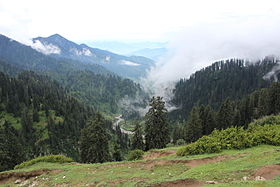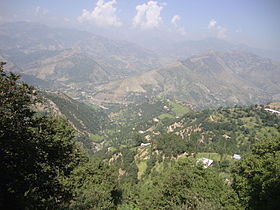Upper Dir
History

Dir was home to various popular civilizations. It has been the place where the Aryans, the Budhists, and the Mughals survived. It was also a home to the Gandhara civilization. It was invaded by Alexander The Great.
In the sixteenth century, it was invaded by the Yousafzai tribe of the Pashtuns.
In 1898, Yousafzai Pashtun Muhammad Sharif Khan was declared the Nawab of Dir. He was succeeded by his son Nawab Aurang Zeb Khan in 1904, who ruled until his death in 1925. Subsequently, his son Shah Jehan Khan succeeded him and ruled the state for almost 35 years. At the time of the independence of Pakistan, in 1947, Dir was still a princely state, separated from Pakistan. It was no later than 1969, when it was annexed with the Khyber Pakhtunkhwa province of Pakistan. Till 1996, Dir was a unit combined district. But in 1996, the Dir District was divided into Upper and Lower Dir districts.
Demographics
| Year | Pop. | ±% p.a. |
|---|---|---|
| 1972 | 251,045 | — |
| 1981 | 362,565 | +4.17% |
| 1998 | 575,858 | +2.76% |
| 2017 | 947,401 | +2.65% |
| 2023 | 1,083,566 | +2.26% |
| Sources: | ||
As of the 2023 census, Upper Dir district has 149,536 households and a population of 1,083,566. The district has a sex ratio of 98.36 males to 100 females and a literacy rate of 46.77%: 62.76% for males and 31.67% for females. 392,214 (36.24% of the surveyed population) are under 10 years of age. 47,842 (4.42%) live in urban areas. 2,415 (0.22%) of the people in the district are from religious minorities, mainly Christians.
Pashto is the predominant language, spoken by 91.02% of the population. Kohistani languages are spoken by 5.11% of the population, and 3.87% of the population speak 'Other' languages.
Tribes
The people groups of the district are various Pashtun tribes of Afghan origin among other clans that settled in the region. These include the following tribes
Administration
Upper Dir District has 4 Tehsils.
Wari and Larjam tehsils are part of newly created District Central Dir District.
National Assembly
This district is represented by one elected MNA (Member of National Assembly) in Pakistan National Assembly. Its constituency is NA-5 (Upper Dir).
| Member of National Assembly | Party Affiliation | Year |
|---|---|---|
| Molana Asad Ullah | Muttahida Majlis-e-Amal | 2002 |
| Najum-din Khan | Pakistan Peoples Party | 2008 |
| Sahibzada Sebgat Ullah | Pakistan Tehreek-e-Insaf | 2018 |
Provincial Assembly
In the provincial assembly of Khyber Pakhtunkhwa, there are three seats for the Upper Dir district. Its constituency is PK-11, PK-12 and PK-13.
| Member of Provincial Assembly | Party Affiliation | Constituency | Year |
|---|---|---|---|
| Gul Ibrahim Khan | Pakistan Tehreek-e-Insaf | PK-11 Upper Dir -I | 2024 |
| Muhammad Yamin | Pakistan Tehreek-e-Insaf | PK-12 Upper Dir -II | 2024 |
| Muhammad Anwar Khan | Pakistan Tehreek-e-Insaf | PK-13 Upper Dir -III | 2024 |
Towns

Except for the town of Dir and a number of rapidly growing towns along the main road, the population is rural, scattered in more than 1200 villages in the deep narrow valleys of the Panjkora and its tributaries.
Of these, notable villages are
Division of Dir

Popular places
Notable people
- Dr Zia Ul Haq (born 1980), university Vice Chancellor
See also
References
- ^ "7th Population and Housing Census - Detailed Results: Table 1" (PDF). www.pbscensus.gov.pk. Pakistan Bureau of Statistics.
- ^ 1998 District Census report of Upper Dir. Census publication. Vol. 104. Islamabad: Population Census Organization, Statistics Division, Government of Pakistan. 2000.
- ^ "About Malakand Division". The Commissioner Of Malakand, The Government Of Khyber Pakhtunkhwa. Archived from the original on 9 February 2019.
- ^ "Population by administrative units 1951-1998" (PDF). Pakistan Bureau of Statistics.
- ^ "7th Population and Housing Census - Detailed Results: Table 9" (PDF). www.pbscensus.gov.pk. Pakistan Bureau of Statistics.
- ^ "7th Population and Housing Census - Detailed Results: Table 11" (PDF). Pakistan Bureau of Statistics.
- ^ Bergen, Peter; Tiedemann, Katherine, eds. (2013). Talibanistan : negotiating the borders between terror, politics and religion (first ed.). Oxford: Oxford University Press. p. 150. ISBN 9780199893096. Retrieved 28 January 2024.
- ^ "District Dir Upper". Government of Khyber Pakhtunkhwa.
- ^ "Election Commission of Pakistan". Election Commission of Pakistan. Archived from the original on 10 November 2015. Retrieved 6 November 2015.
- ^ "Pakistan: North West Frontier Province District, Tehsil and Union code Reference Map - Upper Dir". Relief Web. 1 July 2009. Retrieved 20 January 2024.
